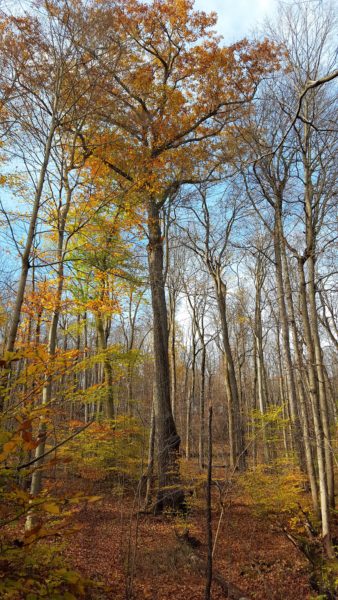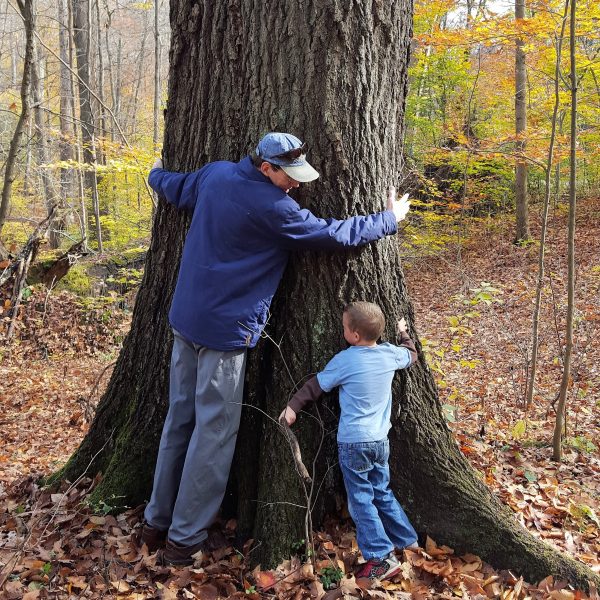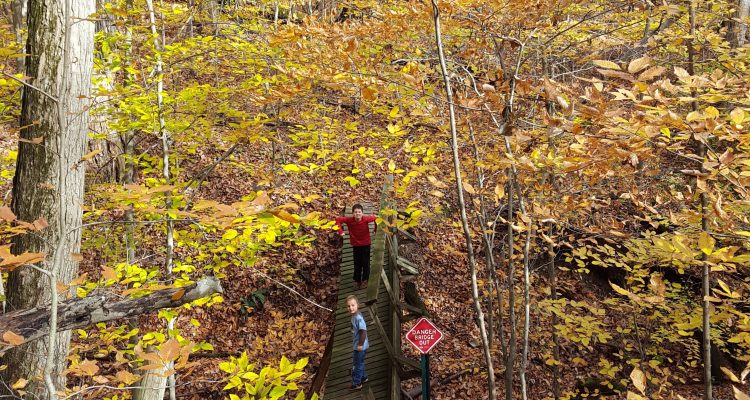I swore to myself I’d never publish this piece. Truth be told, I like you guys a lot—and I appreciate that you read “Valley Views & Varmints”—but since I began this series, I’ve found myself writing about the places I go in this valley that I’d prefer to keep secret. It’s not that I don’t trust you, it’s just that…I’m not sure I trust you. I’m afraid if I tell you about my favorite wild places, you’ll spread the word a little too far, to the types of people who leave cigarette butts on the ground and squish spiders for fun.
But this one is important to me, so raise your right hand. Swear that you will hold sacred what I’m about to tell you, that you’ll promise to honor the forest where giants grow.
If you think I’m a paranoid tree-hugger, then a) you’re absolutely right, and b) you’ve never been to Dysart Woods. It’s just a little place: a 50-acre tract of mixed oak forest in the middle of Belmont County. But Dysart is unique because it’s an old-growth forest, one untouched by human hands or machinery. No logging, no farming, no burning. Dysart is the largest of these in the state, and what you see there is a glimpse of Ohio when it belonged to the native peoples, before settlers began clearing the land. Such virgin forests have a higher biodiversity than their younger counterparts. You’ll find snags (standing dead trees), multilayered canopies, and thick debris on the forest floor. Trees that fall are left where they land so the cycle of decomposition can return nutrients to the soil and nurture a new generation of saplings.
This rare place exists because the original landowners, the Dysart family, made the blessed decision to preserve the original forest. In the 1960’s they sold it to The Nature Conservancy, who in turn sold it to Ohio University with the agreement that it remain a National Natural Landmark. OU now runs an outdoor laboratory there. It provides a unique opportunity for scientists and students to study an old-growth forest, of which only .004% remains in the state. Looking down, you’ll see far more vegetation than you would in a younger forest: more ferns, more moss, and a wider variety of fungi. Two years ago, my sons found a monster patch of puffballs and spent half an hour poking at them.

But you’ll see the best part of Dysart Woods if you look up. The trees really do deserve a hug because the oldest oaks are 400 years old and 140 feet high. You won’t get your arms all the way around them because the trunks are four feet in diameter. When I started toddling around Dysart in the early 80’s, about 50 of the oldest giants still stood. Over the last 40 years, however, forces of nature (remember those derechos?) brought some of them down. In addition, Ohio Valley Coal Company mined under the forest after a lengthy legal battle. Though longwall mining was prohibited and activity was restricted to room and pillar mining, scientists believe that the resulting change in hydrology contributed to the loss of over half of the giants since 2006. Now, you’ll find only a handful left. Four-hundred years is a long time to stand, but if we continue to protect and study Dysart, younger trees will eventually take their place at the top of the canopy and grow to a monstrous—and very huggable—size.
My dad has been taking me to Dysart Woods every October for most of my life. In fact, when I was seven years old he sat me down on a fallen tree and presented a classic philosophical thought experiment.
“Laura,” he asked. “If a tree falls in the woods and no one is around to hear it, does it make a sound?”
Philosopher George Berkeley posed that question. Albert Einstein and Niels Bohr, fathers of quantum mechanics, bandied about an answer in their day, as many great minds have done. I certainly didn’t have an answer. But we hiked and we talked about it. I ask it of myself every time we go back to Dysart. I wonder: Do the giants make a thunderous crash when their lives end in solitude, or do they fall in silence far from the presence of human ears? And more importantly, if their nutrients, their life force, go back into the earth, are they ever truly gone?
The Buddhists like this line of inquiry, too. They might suggest we look for the spirit of the fallen oaks in the tiny growing mushrooms or the cawing crow. They’d advise me not to be sad for a fallen behemoth, but to find it in every other living thing in the forest. Regardless of the greater philosophical meanderings, though, I learned to love ancient trees in Dysart Woods. Every year my father takes a photo of me hugging one of the old giants, even as their numbers dwindle.
Two foot-trails wind their way through the forest. The 0.8-mile red trail leads west; the 0.9-mile blue trail leads east. Together they form a very manageable loop that crosses the road. We bring our dogs with us because it’s a great place to be a dog. (Leashes, of course, are appreciated.) Over the years, each dog’s presence has stamped the annual visit with a temporal touchstone. We hiked with Barney, the wild, smelly Irish setter; Piper, the adventurous white shepherd; Millie, the short-legged, loyal corgi; Suey, the deer-chasing Doberman. Altogether, we’ve brought eleven dogs to Dysart Woods.
Each hike takes about an hour, or possibly longer if you’ve got a set of little legs in your company. In 2014, to my kids’ horror, the car keys fell out of my pocket somewhere in the leaves along that 1.7-mile loop. Thankfully, I found them after 30 minutes beneath a fallen beech tree on the red trail. You can hike at any time, of course, because Dysart shows her beauty 12 months a year. However, there’s one weekend each October that we call “the weekend,” and it’s the sweet spot, the Goldilocks of hiking. It generally falls on the third weekend of October, when the leaves peak. After the first frost, the low-lying vegetation dies away and makes more room for human and canine feet to pass unobstructed. The sky tends to be azure and the colors range from lime green to flaming crimson. A golden carpet covers the trails and the air smells crisp and dry.
If you go, know that the bridges over the streams are rickety and falling apart. The paths go up hills and down into ravines. Wear good shoes. The Ohio University lab asks that you remain on trails and refrain from carelessness. Do not smoke—in fact, don’t even think about bringing a lighter. Don’t pick flowers or vegetation. As the adage goes, take only pictures and leave only footprints.
I’ve spent a lifetime in Dysart Woods. My visits have marked the passage of my childhood into adolescence, youth into adulthood. The trees know me, by now. They’ve heard my voice. In 1988, I bickered with my little brother as we fought to cross a bridge first. In 1993, I muttered and rolled my eyes at the things my dad said as we hiked because he was so terribly uncool. In 2003, I brought my new boyfriend to the woods to meet the giants. In 2009, I threw up in the parking lot when I was pregnant with our second child. This year, I will ask my children that famous question as we walk.

When you go to Dysart Woods, bring a young person with you. Sometimes my boys don’t appreciate the winding roads or the thought of hiking up a hill. Our technological world has cut them off from nature; children increasingly suffer from nature-deficit disorder. One puffball mushroom, however, opened their eyes. They patiently hug the trees now, too, when prompted. Someday, they’ll understand why I ask them to do it.
I want you to know this forest. Only when you’ve stood in a sacred place like Dysart will you understand its value and why it’s worth protecting. You can’t feel it by reading this essay, and the selfish part of me that wants to keep it a secret from the world knows this to be true.
Go to Dysart. Stand beneath the giants. Touch them, these beings that have stood for four human lifetimes. They are other nations. Imagine what they’ve seen.
And promise me, please, that you’ll honor this old-growth forest.
To find Dysart woods, take Belmont exit off I-70. Proceed south toward the town of Belmont on highway 149. In Belmont, turn off 149 and onto highway 147 heading south. Drive south approximately 5 miles. A small wooden Dysart sign on the right indicates the entrance to the property. Rustic restrooms are located adjacent to the white farmhouse on the left. Parking is available at the trailheads.


